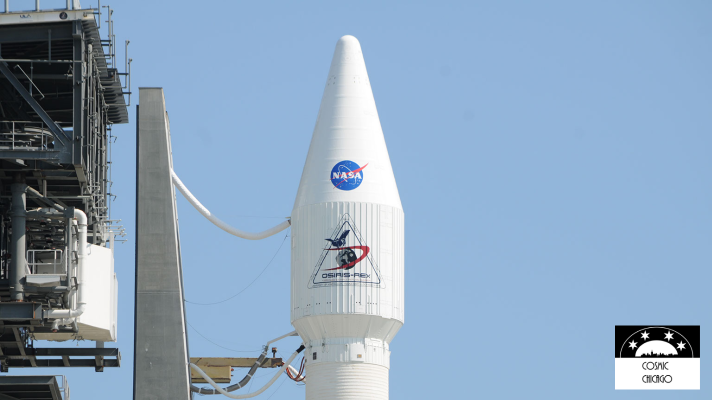NASA is launching the OSIRIS-REx spacecraft to the asteroid Bennu in order to analyze Bennu’s surface before returning to Earth with asteroid regolith. The seven-year mission will be the most significant space sample return since the Apollo missions returned with lunar samples.
OSIRIS-REx is integral to learning more about the origins of our solar system, and this is what you need to know about the mission.
About the OSIRIS-REx Mission

OSIRIS-REx stands for Origins, Spectral Interpretation, Resource Identification, and Security-Regolith Explorer. Dante Lauretta, Principal Investigator at the University of Arizona, devised the impressive acronym to reflect the constant source of scientific curiosity and concern asteroids are. As the third science mission in the NASA New Horizons Program, OSIRIS-REx will travel through our solar system until it reaches its asteroid target, Bennu, and then return to Earth with soil samples in tow.
This mission is significant because asteroids are an uncontaminated source of organic molecules that can hold answers about the origins of life on Earth and the Solar System. Bennu is particularly important among asteroids because its compositional makeup is rich in carbon compounds. To preserve the purity of the asteroid sample, OSIRIS-REx won’t land on Bennu but use an instrument to reach out and touch the surface to collect regolith.
OSIRIS-REx Launch Details

The OSIRIS-REx spacecraft is launching atop an Atlas V from Space Launch Complex 41 at Cape Canaveral Air Force Station no earlier than September 8th, 2016, at 7:05 p.m. EDT. The launch window is open for 120 minutes with a launch period that extends an additional 33 days.
ULA’s Atlas V 411 rocket consists of the payload fairing encapsulating the OSIRIS-REx spacecraft, the Centaur second stage, and the booster.
The Science Instruments Onboard OSIRIS-REx

The OSIRIS-REx spacecraft will carry a payload of five scientific instruments and communication equipment to explore the asteroid Bennu.
- OSIRIS-REx Laser Altimeter (OLA) will scan the asteroid Bennu using infrared light to create 3-D topographic maps.
- OSIRIS-REx Visible and Infrared Spectrometer (OVIRS) will gather information about the mineral and organic composition of Bennu by measuring reflected light to create spectral maps.
- OSIRIS-REx Camera Suite (OCAMS) includes three cameras that will map the entire asteroid through imaging, including special documentation of the asteroid sampling event.
- OSIRIS-REx Thermal Emission Spectrometer (OTES) is a student payload built at Arizona State University that will create thermal emission and mineral maps of Bennu, measuring the surface temperature of the asteroid from infrared wavelength data.
- Regolith X-ray imaging System (REXIS) complements the other instruments onboard OSIRIS-REx and will use X-ray fluorescence spectrometry to measure the elemental composition of Bennu. This student payload was a collaboration between MIT and Harvard University.
- Touch and Go Sample Acquisition Mechanism (TAGSAM) is the articulated arm of OSIRIS-REx that will make contact with Bennu, agitate surface regolith, and collect and then store samples of the asteroid for the return trip to Earth.
- High and Low Gain Antennas will provide Range and Doppler measurements upon contact with the Deep Space Network and then measure Bennu’s mass and gravity field using the radiometric tracking data.
All About Bennu
Bennu is a Near Earth Asteroid (NEA) discovered in 1999 by NASA’s NEO Observation Program. As a Potentially Hazardous Asteroid, Bennu comes close to Earth every six years, and its orbit is on nearly the same plane, making it more accessible than others. Researchers have studied Bennu since its discovery and found its diameter of 1,614 ft gave it a slower spin, or a rate of one rotation every four hours. Observations also showed Bennu to possess a carbon-rich surface of geologic importance to the formation of Earth. All of these factors led NASA to select Bennu as the target asteroid for a mission meant to return samples of asteroid resources from our Solar System back to Earth.
The Journey to Bennu, the Science of OSIRIS-REx, and the Sample Collection and Return

After launch, the spacecraft will begin its journey to Bennu using star-based navigation. OSIRIS-REx will complete several orbits around the Sun before performing two gravity assist maneuvers with Earth to achieve a deep space maneuver that will set it on the same orbit as Bennu.
Once OSIRIS-REx reaches Bennu, it will begin to orbit the asteroid to take pictures and map the surface. Scientists back on Earth will select a sample site based on these images and surface features.
OSIRIS-REx will stop orbiting Bennu long enough for the TAGSAM Sample Return Arm to reach out and collect a surface sample. The material gathered will be stowed in the OSIRIS-REx Sample Return Capsule (SRC) for the ride back to Earth. The SRC is equipped with a heat shield and parachute so that the capsule can make a soft landing. Once the sample is retrieved, research will begin on the material before being made available to partners for collaborative research.
This article was previously published by Sophie Sanchez on ChicagoNow.

